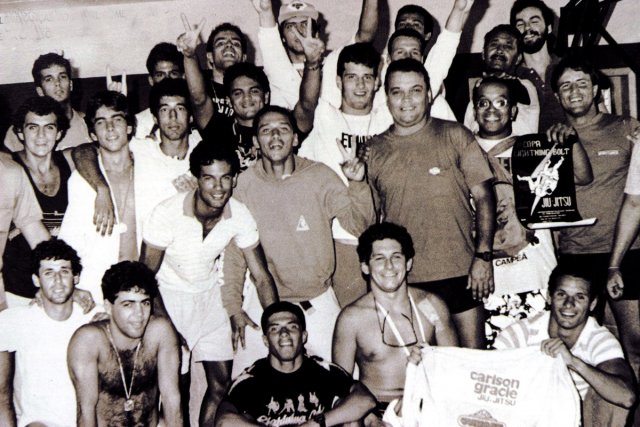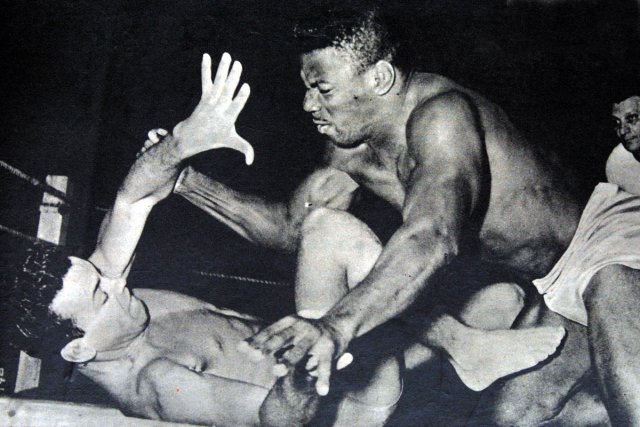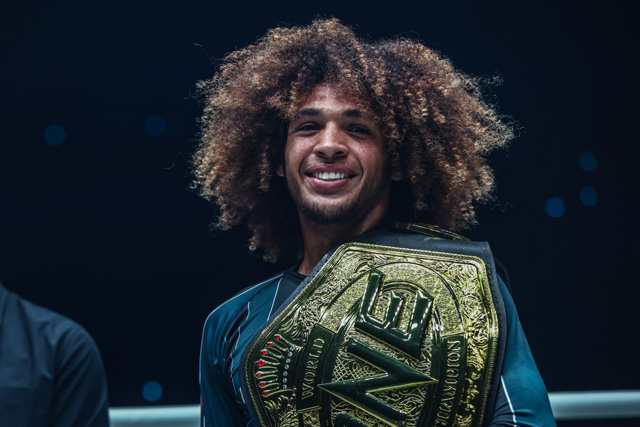Another Chapter Closes in an Enduring Legacy
Lasting Impact

Carlson Gracie was revered by his students. | Photo Courtesy:
Marly Gracie
The press soaked up the drama, resulting in several new articles being published in the main newspapers: A Noite, Ultima Hora, Diario de Noticias and Jornal dos Sports. Unfortunately the violent nature of the Helio-Santana fight led police to prohibit vale tudo fights in Rio de Janeiro, so Carlson and Santana were forced to fight under jiu-jitsu rules with a gi. Still, everyone wanted to see Carlson avenge his uncle, and on Oct. 8, 1955, Maracanazinho Gymnasiun was sold out.
“Fifteen thousand people entered and five thousand weren’t able to get in,” said Carlson, who controlled the action for three rounds. Nevertheless, he could not submit Santana, so the fight ended in a draw. Ten months later, they fought under vale tudo rules in Rio de Janeiro. Scheduled for six 10-minute rounds, the bout ended after 39 minutes, when Carlson forced Santana to quit.
Advertisement
With that, Carlson was consecrated as his uncle’s avenger and took his place as the Gracie family’s top fighter. Backed by the media, he became a celebrity and was almost universally admired, as faithful friend Oswaldo Paqueta recalls.
“Carlson had idol status,” he said. “Once, general Joao Figueiredo
Batista, [who was president of Brazil at the time], saw him at a
steak house and immediately went to his table. He said, ‘You are
the only man that I ever came to a table to compliment.”
HIS TOUGHEST OPPONENTS
After he defeated Santana, Carlson fought him on five other occasions, winning four of them.
“Waldemar was such a tough guy, very slippery,” said Carlson, who went on to fight another former Gracie Academy student to defend his uncle. “Gunair Vial had an issue with Helio and challenged and beat a few members of the academy -- until he challenged me, and he fought me twice. In the first one, I caught him with a rear-naked choke. In the second one, I hurt him a lot during the first round and he was not able to return for the second round.”
The fame and success he enjoyed as Brazil’s premier fighter led to Carlson facing the toughest opponents of his career: Ivan Gomes and Euclides Pereira. However, before he fought them, he met professional wrestler King Kong and finished him inside a few minutes.
“The guy had such fame as a pro-wrestler, and he was too weak,” Carlson said. “I rocked him fast. He fell out of the ring and didn’t return.”
Carlson then fought and defeated Valdemar Viana, and after beating two fighters in Bahia and one in Pernambuco, he answered the challenge from Gomes, a fighter from Paraiba. They fought in Recife on Dec. 28, 1963.
“I only knew he learned a few things from my uncle, George, and had won few times,” Carlson said. “By his weight and size -- he was 1.72 meters tall and weighed 98 kilograms -- I thought he would be out of shape. When he stepped inside the ring and took off his robe, my father got impressed. He looked like Hulk.”
Gomes outweighed Carlson by almost 50 pounds. Most spectators point to this match as one of the most significant fights in vale tudo history. Gomes took down Carlson eight times and spent most of his energy trying to strike him from the guard. In the final round, Carlson landed a damaging jab on Gomes’ chin, but he managed to recover. With no finish, referees declared the bout a draw. Carlson and Gomes became the best of friends. Three months later, Gomes traveled to Rio de Janeiro, partnered with Carlson and opened an academy in Copacabana.
In 1969, following two more fights against Santana, Carlson received an invitation to fight Pereira at Fonte Nova Stadium.
“Euclides was a tough guy and he had beaten Waldemar, but he was defeated by Ivan and challenged me,” Carlson said. “The deal was: no time, no points. When I was in the dressing room warming up, they changed the rules, and points were now in. I decided not to fight, but the audience started to boo. So as not to spoil the party, I decided to step inside the ring. I fixed a rear-naked choke in the beginning of the fight, but he escaped from the ring. After that, the fight got balanced. Referees could point to either one of us as the winner, but since we were in Bahia, they gave him the victory. The audience even booed.”
Afterward, Carlson accepted his final bout and defeated Santana for a fourth time. He retired from the ring to spend time at his gym on Figueiredo de Magalhaes Street in Copacabana, where the master turned jiu-jitsu into a popular sport and built one of the best Brazilian jiu-jitsu teams of all-time.
CARLSON GRACIE: THE COACH
Upon retiring from competition in December 1970, Carlson focused his efforts and attention on his jiu-jitsu academy. This was the only branch of the Gracie Academy located in downtown Rio de Janeiro, and it was under Helio’s control. Helio’s gym was for students of a higher income bracket, while Carlson’s gym attracted people from all classes because of its lower prices.
“Carlson didn’t hide the techniques from the students,” said Fernando Pinduka, who started training at the gym in the 1970s, alongside Sergio Iris, Walter Guimaraes, Rosental and others, and helped form the backbone of Carlson’s first generation of black belts. “The trophy was his goal. He preferred the tough fighter to the businessman. We were trained to compete, while Gracie Academy trained their students for self-defense.”
The rivalry with Helio’s students obliged Carlson to part ways with the Gracie gym. “Each team was allowed to put only two fighters in the competitions and my students won everything,” Carlson said, “so I decided to split up.” The rivalry grew stronger over time, as Carlson’s fighters were the only ones truly prepared for tournament competition. This fact also contributed to the evolution of the sport in Brazil.
“If an opponent like Carlson hadn’t existed,” Pinduka said, “Gracie Jiu-Jitsu wouldn’t have developed.”
Besides high-level competitors such as Royler Gracie, Royce Gracie and Rickson Gracie, Marcelo Behring and the Machado brothers also encouraged Carlson’s students to train even more. Some of the most important matches of all-time were born out of this rivalry: Ricardo de la Riva (Carlson) vs. Royler, Cassio Cardoso (Carlson) vs. Behring, Royler vs. Pascoal (Carlson), Wallid Ismail (Carlson) vs. Renzo, Sergio Bolao (Carlson) vs. Rigan Machado, Ismail (Carlson) vs. Royce and many others.
Carlson trained a total of 92 black belts, and those black belts trained other black belts. As a result, everywhere you look in Brazil and around the globe, you can see a jiu-jitsu fighter who has some connection to him. The difficult training routine and the psychology Carlson employed made the difference between the Carlson Gracie Team and all other gyms, according to Ismail, who lived in the gym when he moved from Manaus to Rio de Janeiro.
“We used to spend the whole day practicing,” said Ismail, the man behind Jungle Fight, Brazil’s top MMA promotion. “The gym seemed like a hostel. Carlson was a genius in the art of training. He used to tell us we were the missile and the opponents were the target. He waited for the other fighters to enter in the competition to define who would fight; and we rocked. I saw a lot of timid fighters become brave by his hands. I didn’t have money or any place to live. He let me train and live there for free. I owe him everything.”
JIU-JITSU VS. LUTA LIVRE
Starting in 1991, the Carlson Gracie Team supremacy on the mats could also be seen in the rings. At that time, Ismail, then a Brazilian jiu-jitsu brown belt, went to a television station and challenged any martial arts style to test itself against jiu-jitsu. Representatives of luta livre did not approve of Ismail’s attitude and invaded the Nastra Cup. As a result, a three-fight competition was held at the Grajau gym. For the first time, Carlson took off the gi and passed on his MMA knowledge to his students.
A part of Romero Jacare’s team, Fabio Gurgel was selected to represent jiu-jitsu, along with rivals Ismail and Murilo Bustamante.
“It was the best time of my life,” Gurgel said. “Carlson taught us a lot and we won the three fights.”
Following the victory, Carlson’s students also began to train without the gi; and after the MMA boom in the United States, they put aside their gi altogether. The last Brazilian jiu-jitsu tournament controlled by the Carlson Gracie Team was the 1994 Brazilian Nationals. Afterward, Carlson moved to Los Angeles, leaving the team without its leader. However, it was quickly transformed into an MMA power on the strength of performances by Vitor Belfort, Bustamante, Ismail, Allan Goes, Bitetti, Mario Sperry, Crezio de Souza, Andre Pederneiras and Carlao Barreto in shows around the world.
Carlson’s profile grew in stature. However, the distance between him in Los Angeles and the students in Brazil created some issues. They disbanded in 2000 due to financial disagreements, and within a few months, Brazilian Top Team was founded. Some three years later, Carlson relocated to Chicago to live with his son, Carlson Jr. There, he trained noteworthy talents like future WEC champion Miguel Torres and eventual Ultimate Fighting Championship hall of famer Stephan Bonnar.
On Feb. 1, 2006, Carlson died due to heart failure. He left behind a legacy that resonates throughout the martial arts world to this day.
Still revered across Brazil, Carlson, his father Carlos and his uncle Helio are close to receiving further recognition in Rio de Janeiro. Mauricio Carneiro, a black belt who trained under Carlson, is currently working with the city’s mayor to erect a statue of the three Gracies in front of the subway in Copacabana, one block away from Carlson’s gym.
“The secretary already authorized it. All we need is the mayor’s signature,” Carneiro said. “Carlos and Helio transformed the jiu-jitsu learned from [Maeda] into a philosophy of life, and Carlson is the one who made jiu-jitsu popular all over Brazil. Today, there are many people around the world making a living from MMA and jiu-jitsu thanks to those three Brazilians. They deserve this honor from Rio.”
« Previous Video: Benson Henderson’s ‘Terrible Performance’
Next Grappling Coverage: ADCC 2015 Day 2 Results & Play-by-Play »
More




 Grappling Coverage: BJJ, Wrestling, No-Gi
Grappling Coverage: BJJ, Wrestling, No-Gi



